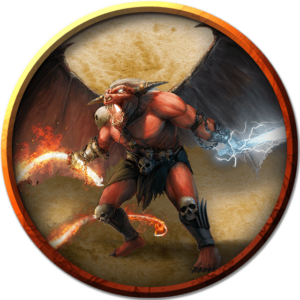
The fifth edition of D&D is fairly compatible with adventures from the first, second, and third editions of the game-enough so that quick conversions of adventures from such editions are possible. Careful conversion is the alternative. As the DM-the one who creates and runs adventures-the choice is yours. The following sections provide guidelines for careful conversions, quick conversions, and the conversion of treasure.
Note that conversion of D&D material is more art than science. The aim of conversion is to arrive at something that feels like the older-edition version, rather than at an exact replication. The guidelines in this document are intended to help you create what you want, not to force your choices along particular lines.
Conversions
Converting an adventure to fifth edition is pretty easy. Don't bother converting adventure elements you know your players are unlikely to notice or use. Add adventure elements you'd like to see or use (i.e. traps, scenes, monsters, etc.).
Encounter Difficulty
1st and 2nd Editions
For encounters, the first step is usually to decide what the difficulty of the encounter should be. Doing so requires more intuition than science. Further, the design from edition to edition and adventure to adventure varies on this point. For first edition (1e) and second edition (2e), encounters were often designed to be on the easy side. This sort of pacing allowed the characters to do more exploring and have numerous encounters before resting and retreating from the dungeon.
Ideally, the characters could reach one or more significant encounters or areas, revealing more of the adventure site's background or story, before retreating. Further, the Dungeon Master could more easily allow disparate groups of foes, once they were alerted to intruders, to join an ongoing fight. You can replicate such pacing by keeping to easy-to-medium encounter groups in the dungeon without reducing the number of encounters.
3rd and 4th Editions
In third edition (3e or 3.5) and fourth edition, the encounter level designated for an encounter is useful for determining the intended encounter difficulty based on the level range of the adventure. (In the case of fourth edition, the actual difficulty level should be taken to be two-thirds of the designated encounter level.) For example, if the encounter level is 9 in an adventure designated to be for 7th-level characters, the encounter is intended to be hard or deadly.
Encounter Structure
Use the encounter as written to decide on its monster composition in fifth edition. Then use the monsters' challenge ratings, as described in the Monster Manual, along with the "Creating Encounters" section in chapter 3 of the Dungeon Master's Guide, to modify the encounter to the desired difficulty. An important aspect of this conversion is providing an experience similar to the original. The number of monsters matters much less than the impression the encounter makes on the players. With that guideline in mind, remember to adjust for possible reinforcements. When multiple groups of opponents can converge on the characters, it can make for a dynamic battle. But such a conflict can also be deadly, which is fine if that's the intent. However, you can reduce the number of potential foes (all the way to zero), move them so they're not potential reinforcements, or place impediments in the site to prevent easy reinforcement.
Features, Hazards, and Terrain
An encounter includes site features, hazards, and terrain, and these elements can occur with or without monsters being present. Much of the time, you can use such elements without any new rules; it's enough for you to know the rules in the Player's Handbook on cover, difficult terrain, falling, holding breath, perception and investigation, and special movement. You can make exact conversions, such as for secret doors and wilderness hazards, using the guidelines in chapter 5 of the Dungeon Master's Guide.
To convert traps and damaging hazards, use the Trap Save DCs and Attack Bonuses and Damage Severity by Level tables from that chapter. In third and fourth editions, encounter areas are often quite detailed. Don't feel the need to use every detail presented in adventures from those editions. Convert whatever seems likely to be of interest to your players and leave the rest for improvisation later. For example, a third edition adventure might tell you how to push over a pillar, yet characters seldom decide to push over pillars or attack statues, unless you call attention to an exploitable weakness in such structures. In contrast, it's not unusual for someone to try to break down a locked door, rather than picking the lock.
New Monsters
In older adventures, you'll sometimes run across creatures that lack a published equivalent in fifth edition. In this case, the "Creating a Monster" section in chapter 9 of the Dungeon Master's Guide is your best tool. The "For the DM: Race Conversions" section in this document can also be helpful. If you choose to create the monster whole cloth, start by replicating the original monster as closely as possible using elements from fifth edition.
Use the HD as the creature's HD in fifth edition (the level of a fourth edition monster can determine the number of HD it has). Ability scores should be in the fifth edition range, from 3 to 30; third and fourth edition ability scores often need to be reduced. For special traits and attacks, use existing creatures as guidelines. Once you've converted a monster to fifth edition or created a new one, you can use the Monster Statistics by Challenge Rating table in the Dungeon Master's Guide to determine the creature's challenge rating. Then, you can adjust HD and other statistics to get the challenge rating you desire.
Treasure
In a careful conversion of treasure, you need to create or roll treasure as if creating it from scratch for the adventure. Use the Individual Treasure and Treasure Hoard tables in chapter 7 of the Dungeon Master's Guide to create new assortments of treasure, using what's in the original adventure as a guideline. Be sure to read the "Treasure Tables" section of that chapter to decide how you'll use the tables in recreating the treasure. See also the "Treasure Conversions" section later in this document.
Magic Items
Whenever possible, magic items should be swapped for existing magic items from the Dungeon Master's Guide. If this strategy fails, chapter 9 of that book includes rules for modifying magic items and creating new ones. Use the original item as a starting point and existing items as guidelines.
Quick Conversions
Pro Tip
- Use your Dungeon Master Screen and change monster HP, AC, etc. as needed, if the encounter is too week or too strong for characters. The players will never know any different, trust.
Rather than going through the work of full conversion, you may use published adventures from the first three D&D editions as they're printed. You can "convert" during play using the guidelines in this section. Fourth edition adventures aren't usually amenable to quick conversion.
When you do so, it will be difficult to give experience points based on encounters and to determine encounter difficulty accurately. Therefore, be prepared to improvise and allow level advancement through alternative methods, such as those described in chapter 8 of the Dungeon Master's Guide.
The first task is to select an adventure of the appropriate level for your player characters. Characters of a level in the middle of a suggested level range are likely to find the most challenge with the least overt risk of excessively difficult encounters. In any case, adventures along the lower and middle parts of the level spectrum work better with quick conversion.
Once you've chosen the adventure, use the following guidelines: Monster Statistics.
1st and 2nd Editions
For first edition and second edition, you can use the shorthand monster statistics in the adventure. In these adventures, monsters are often more numerous, but they typically deal lower damage and have fewer hit points than their fifth edition counterparts. Make the following changes to those first- and second-edition monsters:
- Armor Class equals 19 minus the creature's AC, up to AC 22.
- Attack roll modifiers are HD/2 + 2, up to +12.
- Saving throw DCs are 8 + HD/2, up to 20
- If a creature has to make a check or saving throw, and should be good at the roll, use the creature's HD/2 + 2 as a bonus on the roll. Otherwise, use no modifier, or use a penalty to reflect something the creature should be bad at.
3rd Edition
In third edition, you can use monster statistics included in an adventure as a guide. Monster distribution in this edition is fairly close to the distribution in fifth edition. As in earlier editions, such creatures often deal lower damage and have fewer hit points than their fifth edition counterparts. Most statistics in third edition include the creature's ability scores. Use the following parameters:
- Armor Class can be an average of touch AC and actual AC, or 20 percent lower than in third edition. The upper limit is 22.
- Attack roll modifiers are the appropriate ability score modifier + 3.
- Saving throw DCs are 10 + the appropriate ability score modifier.
- If a creature has to make a check or saving throw, use its ability score modifiers. Grant it a +3 bonus if it should be good at the roll.
Monster Groups. If a group of monsters has 7 or more members, it should be evaluated to see if numbers should be reduced. Such a reduction is especially important for player characters of lower than 5th level.
Spells. For spells, use the most closely matching spells from the fifth edition Player's Handbook. You can assign spellcasters cantrips but doing so is optional. Third edition's 0-level spells can be used as guidelines for such selections.
Traps. For traps, improvise by using the guidelines in chapter 5 of the Dungeon Master's Guide. Your best tools are the Trap Save DCs and Attack Bonuses and Damage Severity by Level tables from that chapter. Keep copies of those tables handy. Also, keep falling damage in mind.
Treasure. Adventures in previous editions often contain more treasure than is common in fifth edition. In third edition, NPCs were especially rich sources of magic items. When improvising, give out only the treasure you're happy with the characters acquiring.
Treasure Conversions
In fifth edition, treasure isn't as abundant and magic items aren't as necessary to character performance as in previous editions.
As the Dungeon Master's Guide says, you can hand out as much or as little treasure as you want. Instead of painstakingly recreating treasure to fifth edition parameters, you can use the tables in that book as guidelines for intuitively reconstructing an adventure's treasure. Alternatively, you can hand out whatever is in the adventure, modified to account for fifth edition constraints.
One such constraint is that the highest bonus in fifth edition is usually +3, although a particularly mighty legendary item could confer a +4 bonus. A +6 weapon might have been essential for a particular fourth edition character to function, but even a +1 weapon makes a similar fifth edition character better. Although a character might have had a weapon with a high bonus in a previous edition, maintaining a correspondingly high bonus in fifth edition is unnecessary. Further, the functions of a magic weapon or armor, unrelated to its bonus, are often the most interesting aspects of the item.
Another constraint, although one that is less strict, is the amount of money and salable goods that characters can acquire. The Treasure Hoard tables in the Dungeon Master's Guide show appropriate amounts for accumulated treasure. At each level, a party of adventurers has access to two or three hoards from the appropriate hoard tables.
Also read, Convert Old Dungeons and Dragons Characters





